(I run a blog unrelated to gardening, but I though that may be information on my attempts of growing grapes in Texas could be helpful? The original is here, with the better-quality photographs. Somehow, I was not very successful with preserving the picture quality when uploading them to this forum...
https://babytrilingual.blogspo...)
I wasn't sure whether grapes can grow in North-Texas, Dallas area. Brief reading of some internet pages confirmed my suspicions. The problems in Texas are related to plant deceases - the mild winters do not kill bacteria that cause the Pierce Disease. Pierce's disease is a disease that affects grapevines (Vitis vinifera). The disease is prevalent across the United States, from Florida to California.
However, there was some hope - I figured that several sorts of Grapevines were resistant to this disease, thanks to Thomas Volney Munson, who was a horticulturist and breeder of grapes in Texas.
This way or the other, we built the trellis and planted Spanish Grape, resistant to Pierce's disease.

Spanish grape over the trellis that we constructed in our back yard
The result was quite astonishing - during the second year, the grape took over most of the trellis, and we had a bucket of grapes!

Spanish grape, 2 years after planting
The black grapes gave us aromatic grape juice, and I even made one bottle of extremely sweet, and very alcoholic wine. The next year we had even more grapes, although many were affected. But the third year was a disaster. Every single grape dried while being still green. That disease - the "Black Rot", I learned it was - did not even let my grapes ripen!

I started to research all about the Black Rot and how to get rid of it. I came across different methods and opinions. I particularly remember a video from one frustrated grape grower. It went approximately like this:
"I tried the organic treatment. Than I tried sulfur, and copper, and dithiocarbamate. Then I got rid of every single grapevine plant and planted new ones instead. The Black Rot persisted. The only way to get rid of it is to burn all my fields, my house, everything around and start all over again"
"Wow", I thought to myself. "Let's not exaggerate!" So I am not planning on burning anything, but that was helpful for lowering my expectations. Back rot is a serious stuff. This is what internet has to say about the Black Rot:
Black rot, caused by the fungus Guignardia bidwellii, is a serious disease of cultivated and wild grapes. The disease is most destructive in warm, wet seasons. It attacks all green parts of the vine – leaves, shoots, leaf and fruit stems, tendrils, and fruit.
So it is fungus. I am not sure how the knowledge on whether it is a fungal or a bacterial disease is supposed to help me, but here we are.
I read more of the Internet, and equipped myself with Sulfur, Copper and Mancozeb fungicides. The pictures of the sprayer and the fungicides are shown here. The sprayer (that is called "Chapin", but there are many different reincarnations of this specific one) I got in a local store.
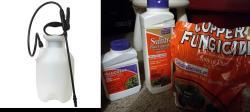
Sprayer and fungicides in my possession
Now, I have to say that I hate spraying chemicals. As I was spraying, multiple moth creatures flew from under the heavy leaves of the grapevine. They made it their home - and I might have destroyed it! On the other hand, I am also the one who created their habitat... Now I have many doubts on whether I should have tried growing grapes in Texas in the first place. Now all these fungicides really get on my nerves (may be even literally - who knows what one breathes in when spraying, even if wearing appropriate mask and PPE!). This way or the other, here is my spray schedule:
My fungicide spray schedule 2020 (Don't use this as an instruction manual because it did not really work. I have absolutely no knowledge in chemistry of fungicides! And please, do comment on what I am doing wrong - I do hope to learn and to become wiser!)
Mid-February (about 1 week before we saw the first green leaves appearing): Copper Fungicide
Beginning of March: Mancozeb
Beginning of April: Copper Fungicide
Mid-April: Sulfur
Mid-May: I thought to quit spraying, as the grapes looked rather healthy. Then out of sudden I saw rot on my leaves. So I sprayed Mancozeb.
Beginning of June: By end-May the rot progressed. So I sprayed Copper. I am desperate.
Here is a link discussing efficiency of various sprays to different diseases:
https://ag.umass.edu/fruit/ne-...
Now, I have to say that the manufacturer's instructions on concentration of the fungicides are very vague. It goes "per hectare" (really??? How am I supposed to scale this to my single grapevine?). I need my concentration "per Gallon". So I used Amazon user reviews in order to figure out the concentration (how much lower can one fall?!) This way or the other, I used 1.5 Table Spoons per gallon of whatever fungicide. Whether this is too much or not enough, I do not know. It might have slowed the rot down, but the fact is that the black rot is still here.
Looks like I lost my battle against the rot. I started to spot the rot everywhere - on the leaves of my beautiful, wonderful thirty-years old mulberry trees, on the random trees in our neighborhood, on my roses. For some reason, looks like the spot appear on the leaves of some plants, but not on the other: the rose is affected, but the surrounding mint is not. My grapevine is surrounded by some random wall climber which is not affected. The pomegranate tree, planted under the Grape, and over which my Grape likes to twist around, does not seem to be affected.

Keeping this strange Black Rot selectivity to victim-plants in mind, and inspired by T. V. Munson (mentioned in the beginning of this article), we decided to try one more experiment. We constructed a trellis over our driveway, and planted several grapes that are supposed to be stable against Pierce's disease: Blanc du Bois, Champanel and Roucaneuf. Our source of knowledge was Texas A&M article, that can be found over here:
https://aggie-horticulture.tam...
My spouse also brought Thompson Seedless - so we planted it as well, although it is not in the list of the Pierce's disease stable grapes. The idea is to figure out which one is also stable against the rot, and then may be replace all of the rest with the most stable one. If not, we'll use the trellis for some other climber, appropriate for Texas (sigh...) !
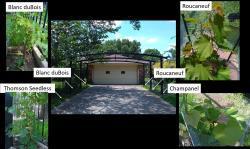
The new grapes do grow nicely. They got the same share of the chemical spray this year as our mature Spanish Grape did. The grapes are somewhat affected, although the major problem in case of these newly planted grapes is something different: it is a "patterned-hole" problem, as I call it. Blanc du Bois and Thomson Seedless leaves are covered by pattern of holes throughout.
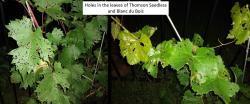
And now we finally discovered this leaf eater on our Roucaneuf, Spanish Grape and Blanc Du Bois:
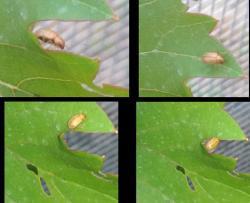
This is (probably) Grapevine Fidia on our Roucaneuf leaf.
On the USDA website I found out this interesting resource about insects and bugs that eat grape leaves. Looks like our little bug is named "Grapevine Fidia" (what a romantic name for someone that harmful!). It may be that I am mistaken in my identification (I am not a biologist - in the best case I may be able to tell a bush from a tree, but not always - some trees turn out to be bushes, and vice versa!), so judge by yourself.)
USDA article for identification of Grapevine-damaging insects:
https://naldc.nal.usda.gov/dow...
And here is the excerpt from the USDA resource that I used for identification of this Grapevine Fidia, so you can judge whether my identification is correct:
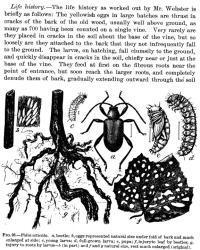
Now, of cause it is not yet the end to our troubles. Today I also found these eggs on my Spanish Grapevine. I wanted to kick them off and discard them carefully in a trash can but my kids protested and insisted to keep them in a glass jar, to see who will hatch from these. Some people keep pets, others keep pests.
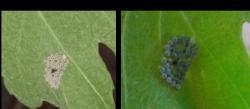
Who laid these eggs on our Spanish Grapevine?
Well, don't forget the aphids! Those are the little eaters of the fresh, green leaves that swarm the young grapevine branches and leaves. Lady bugs to the rescue! Lady bugs eat aphids, so here is one possible organic remedy. I find aphids the least annoying of all of our problems - spraying them off with water hose is fun, and even if not, the rest of the plagues of Texas are much more deadly to the grapevine than the aphids (at least so far...)
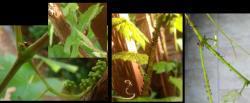
Well, this isn't exactly encouraging, is it?
Why can't all plants be like our unidentified wall climber? What a lovely thing - it simply grows, unaffected by any Black rot, Pierce's disease, aphids, Fidias or what not...

Now, knowing all the difficulties related to Grapevine growing in Dallas, Texas - would I do this again? Most probably not. It looks like Texas and Grapes are incompatible. It is as if the entire raison d'être of the land of Texas is to kill grapevines. I do not get it. Let's say the Black Rot, and Fidia, and aphids, and what not will succeed in killing my grapevine plants. And then what? What all of these will feed upon? It would make sense to kill it a little bit, leaving for us at least 50% every summer. But from what I saw last year, the Black Rot in particular wants the 100% of it!
Let us see how it will continue. I have that strange hope that may be the affected grapes on our new mixed trellis will be able to communicate their immunity (if any of them indeed possesses it) to the rest of the grape plants. On the other hand, I see that my mint does not communicate anything of this sort to my roses, and my unidentified wall climber does not share with my Spanish grape its recipe for survival. May be, after all, I am not suppose to grow grapes in North Texas...
But if any brave soul finds this post entry helpful and inspiring, here are some more useful links:
Here is where we purchased Champanel and Blanc du Bois.
https://www.willisorchards.com...
And here, we found Roucaneuf:
https://ediblelandscaping.com/...










